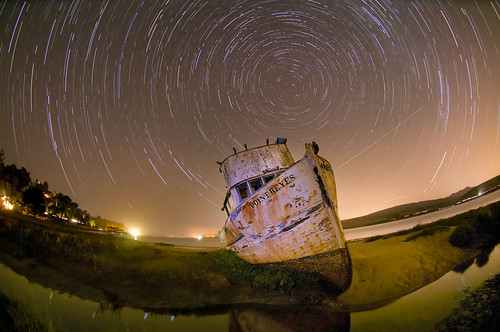
Between Earth and Sky, photo by Harold Davis. View this image larger.
On our way home from a sunset-to-night hike on the Tomales Point fork of Point Reyes, Mark and I stopped at the wreck of the Point Reyes fishing trawler. Many people like to photograph this trawler, which is easily accessible outside of Inverness, California.
The week before, at my Point Reyes night photography workshop, I’d been stymied in my idea of stacking photos to produce circular star trails (stymied because it was cloudy). But this time it was clear. The stars were bright, although a little less than on Tomales Point, probably because of the ambient light pollution.
I pointed the camera north, and used a digital fisheye lens to maximize the celestial rotation of the star trails.
First I tested the light with a one minute exposure at ISO 800 at f/3.5. Then I made an eight minute ISO 100 exposure (with in-camera long exposure noise reduction enabled) for the foreground. This image in its entirety is found below (I think it is interesting in its own right, with the still stars at the center and circular star trails around the edges).
Next, I turned noise reduction off, and programmed my Nikon MC-36 remote for twenty exposures, each capture at four minutes, ISO 100, and f/5.6.
It was damp and a bit chilly in the dark, and for a while Mark and I left my camera on autopilot and sat some distance away in my car, listening to the superb and eerie music of Alison Krauss and Robert Plant. After twelve exposures (about 48 minutes) our patience wore out and weariness won. Mark had a plane to catch in the morning for a business meeting, and I’ve been going on fumes since Katie Rose was born. I stopped the automated exposure process, and packed it in.
This morning, I combined the thirteen images in Photoshop using the Statistics script, choosing Maximum as the method for combination. An airplane trail in one of the captures made it into the stack, and I decided to keep this apparent visual anomaly. Finally, I layered in the longer exposure for the detail in the foreground and boat.
[Above: Thirteen captures, all captures Nikon D300, 10.5mm digital fisheye, tripod mounted; one capture 8 minutes at f/3.5 and ISO 100; twelve captures 4 minutes at f/5.6 and ISO 100; star trails created by statistical stacking of 13 exposures; foreground created by layer with the 8 minute exposure using a gradient and layer mask. Below: Nikon D300, 10.5mm digital fisheye, 8 minutes at f/3.5 and ISO 100, tripod mounted.]
View this image larger.

Pingback: Photoblog 2.0: » Photoblog 2.0 Archive: » Dusk at Pirate’s Cove
Pingback: Photoblog 2.0: » Photoblog 2.0 Archive: » Yosemite by Moon and Star
Pingback: Photoblog 2.0: » Photoblog 2.0 Archive: » Bridge and Stars
Pingback: Photoblog 2.0: » Photoblog 2.0 Archive: » Edge of Night
Pingback: Photoblog 2.0: » Photoblog 2.0 Archive: » Stacking Star Trails: Tips & Techniques
Pingback: Moonset over San Francisco | Photoblog 2.0
Pingback: Morse Code | Photoblog 2.0
Pingback: Lost Horizon | Photoblog 2.0
Pingback: Fisheye Family | Photoblog 2.0
Pingback: Yosemite Night | Photoblog 2.0
Pingback: Stacking Star Trails | Photoblog 2.0
JeppeTT
6 Jan 2010Hello Harold.
I think your photos are absolutely impressing, and you certainly make me want to experiment with it myself. I just don’t quite understand how you calculate your f-stops at long shutter speed?
Pingback: FREEDOM OF THE NIGHT عکاسی در شب « Best Photo Of The Day
Pingback: Photographing the Point Reyes boat with my iPhone and the Waterlogue app
Pingback: Waterlogue and Harold Davis iPhoneography
Pingback: Blast from the Past: Between Earth and Sky
Pingback: My Back Pages
Pingback: Wreck of the Point Reyes – Harold Davis